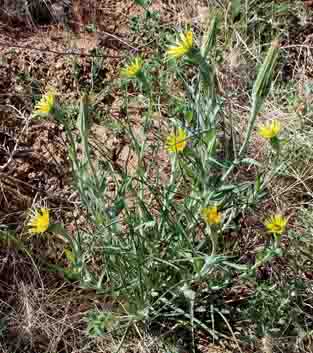 |
Food:
"The thick, fleshy roots of all 3 species, collected before the flower stalks appear, can be eater raw, roasted, fried or boiled, but those of the cultivated species (common salsfy) are the largest and tastiest. They are said to taste like parsmips. Salsify roots have also been dried ground and added to cakes or roasted until they are dark brown, ground and used as a coffee substitute. Tender young leaves, buds and flowers have been added to salads or served as a cooked vegetable. The young stalks and root crowns can be gently simmered, like asparagus (Asparagus officinalis) and artichokes (Cynara scolymus), respectively. The seeds can be used to make tasty sprouts. (Kershaw 164)
"Harvest first-year roots, or second-year before the flower stalk appears (it is difficult to identify at these times; ex. an immature look-alike is Death Camas - Zigadenus spp.); otherwise, the root is too tough and bitter. The root tastes somewhat like oysters when cooked, especially the purple flowered variety. It is best in a white sauce over pasta. Also good in stew, chowder, and gumbo." (Seebeck 77)
Recipe 1: Trifecta Salsify Sampler
"A real dinner party crowd pleaser. Perfect in spring or early summer.
Harvest flower buds before they have opened. Also harvest leaves and stalks. Rinse all thoroughly in water, and gently pat dry.
Separate buds from stalks. Remove leaves from stalks and make three piles: buds, leaves, and stalks. Gently steam stalks, and place on plate, saute leaves for just a few minutes in olive oil. Sprinkle salt on top. Place on plate with stalks. Garnish with raw or steamed flower buds. Serve hot or at room temperature.
Variation: Drizzle truffle oil or hollandaise sauce over final product.
Recipe 2: Salsify Leaves Pasta Primavera
"Substitute salsify leaves for the pasta in your favorite recipe.
Harvest 4 cups leaves; wash and set aside. Prepare the following vegetables buy chopping into bite-size pieces: 1 zucchini, 1 yellow summer squash, 1 cup cherry tomatoes . Toss with enough olive oil to lightly coat the veggies; add 1 teaspoon salt. Toast in oven ant 375 degrees F until veggies are soft, about 45 minutes.
Meanwhile bring a pot of water to a boil. Boil salsify leaves for 5 minutes; drain.
To serve, line plates or serving bowl withy the boiled leaves. Top with roasted vegetables. Sprinkle with a handful of pine nuts and plenty of fresh ground black pepper. Add Parmesan cheese if desired.
Variation: For a raw pasta salad, simply use all the listed ingredients, but do not cook. Toss well with an olive oil, vinegar, and tahini dressing. Allow to sit in dressing for 10-30 minutes before serving. (Morgan 61-2)
Medicine:
"These plants were used for many years to relieve heartburn and to stimulate urination (especially in the treatment of kidney stones). The milky juice was taken to cure indigestion and was applied to dressings to stop oozing and bleeding of sores and wounds. Common salsify tea was used as a drink or lotion to treat the bites of mad coyotes on both humans and livestock." (Kershaw 164)
Other Uses:
"Some tribes gathered the rubbery sap from broken stems and leaves, dried it and rolled it into balls. It was chewed like gum." (Kershaw 164)
Internet Resources